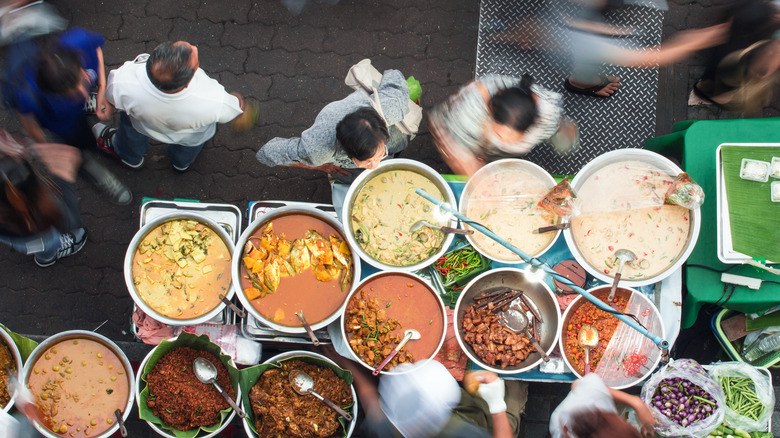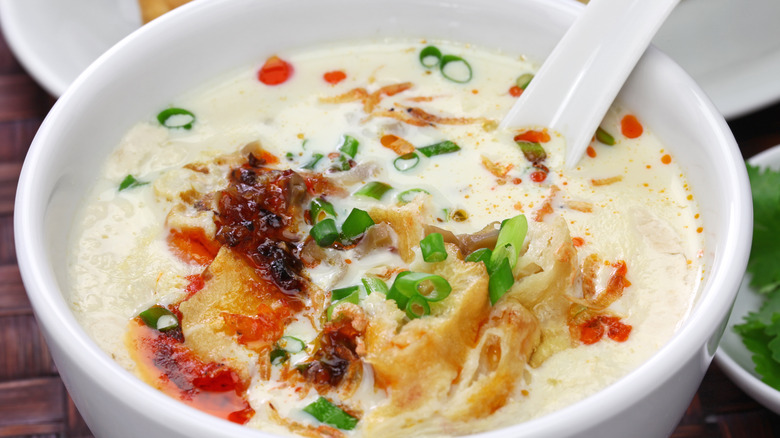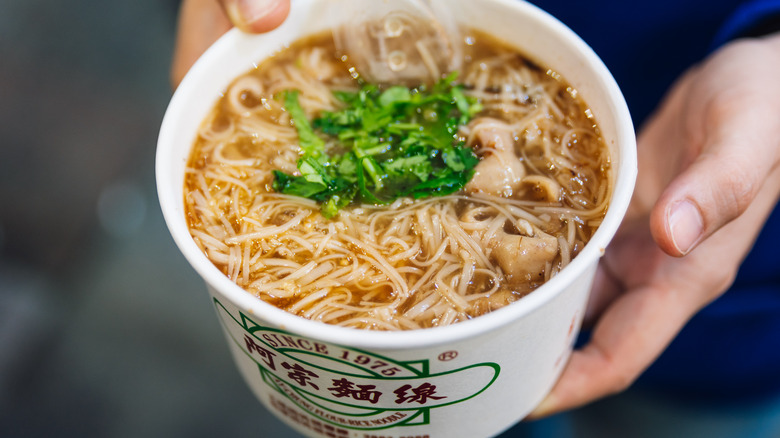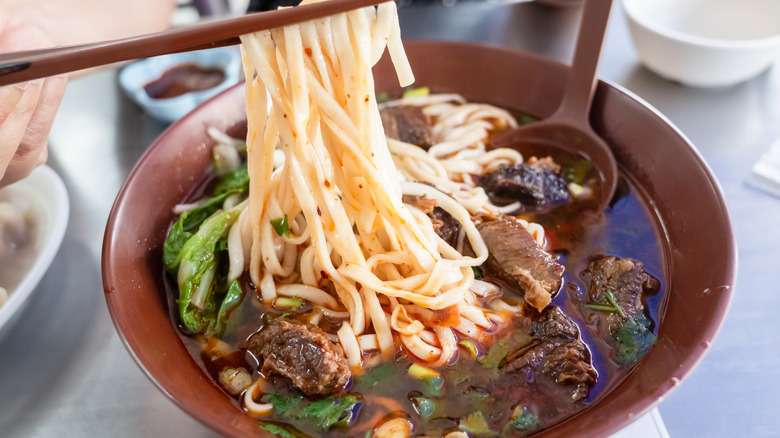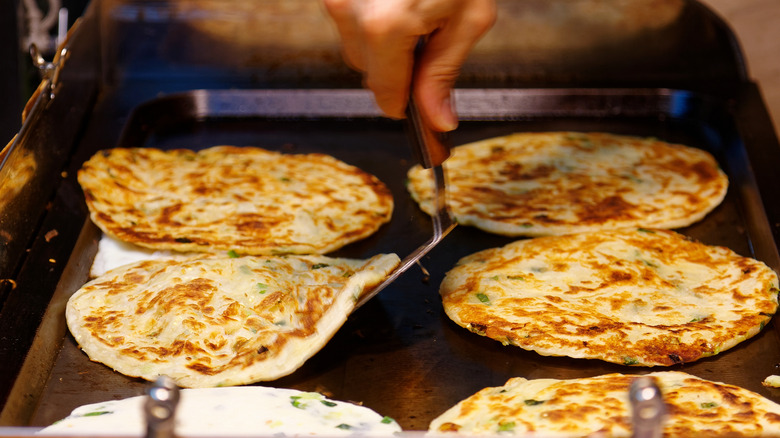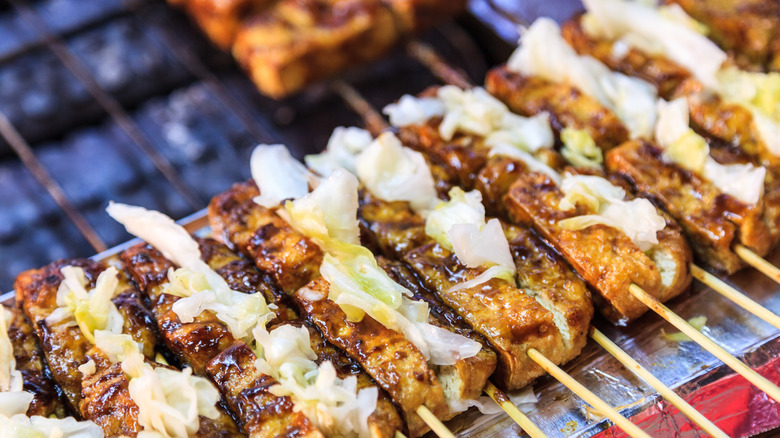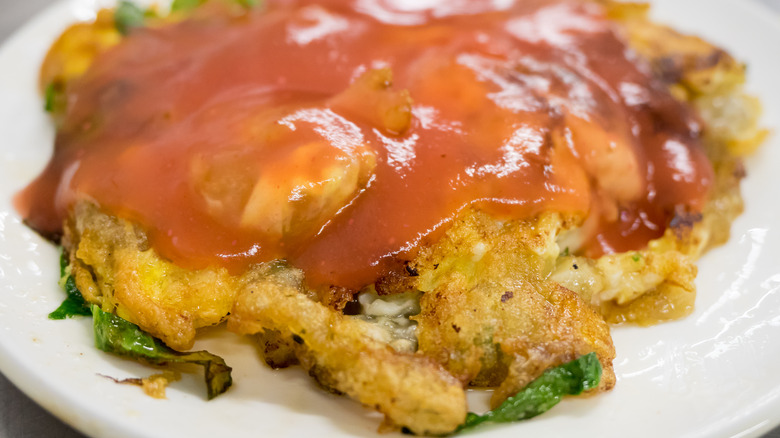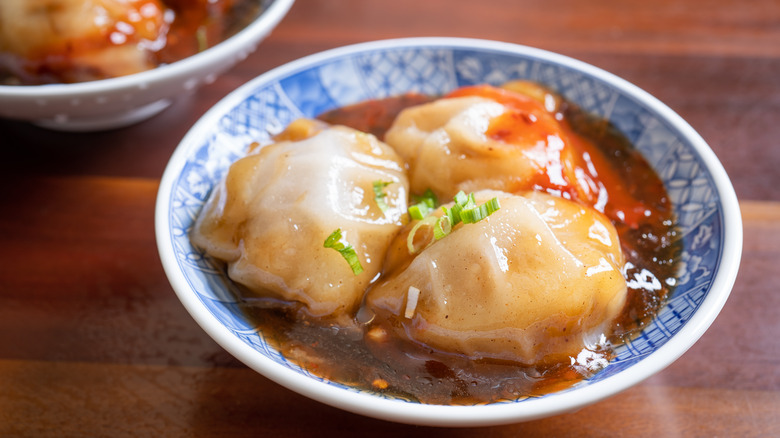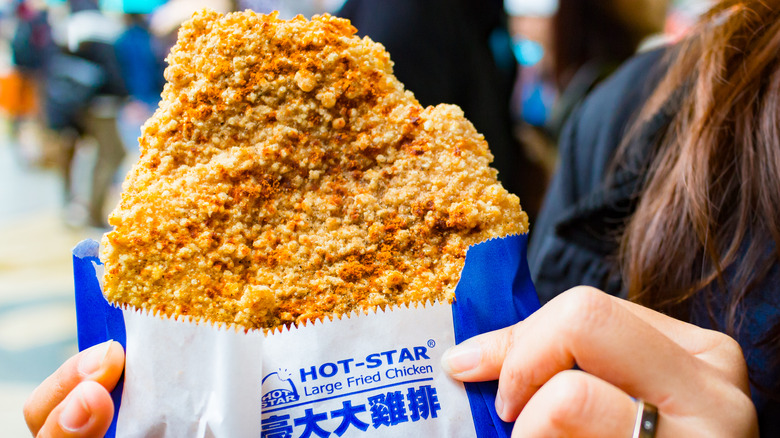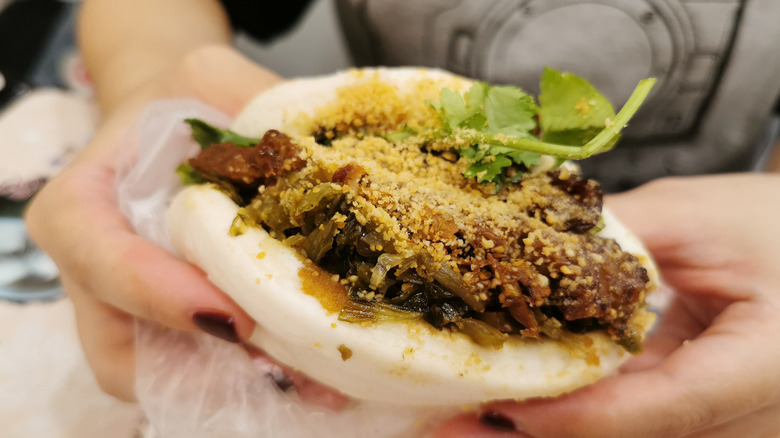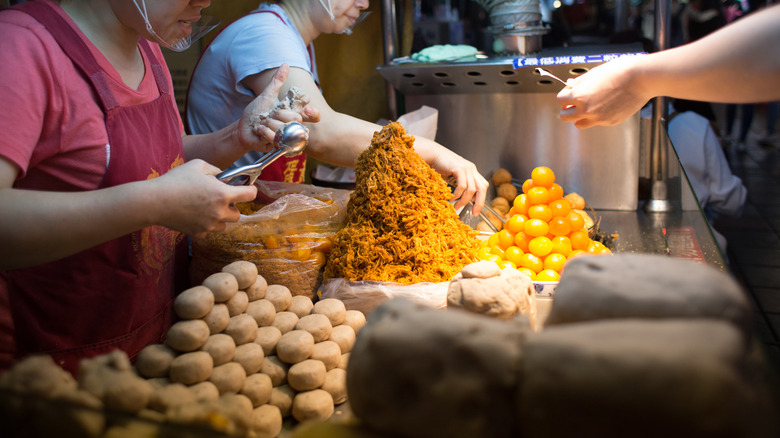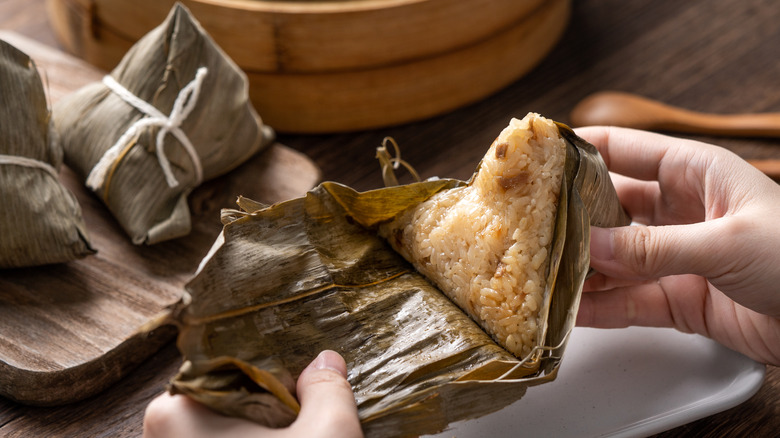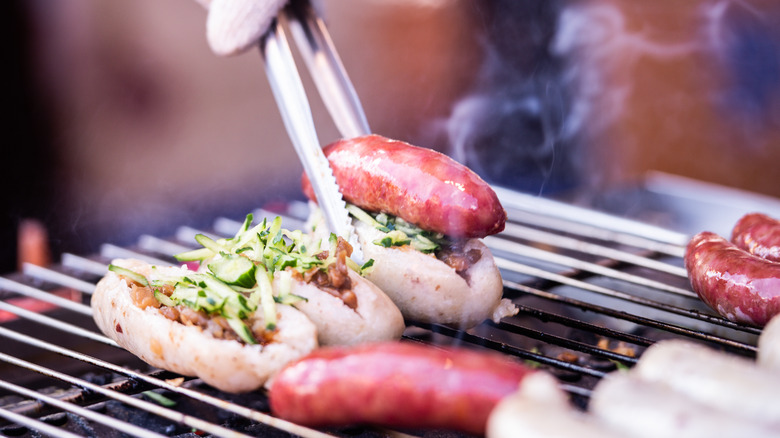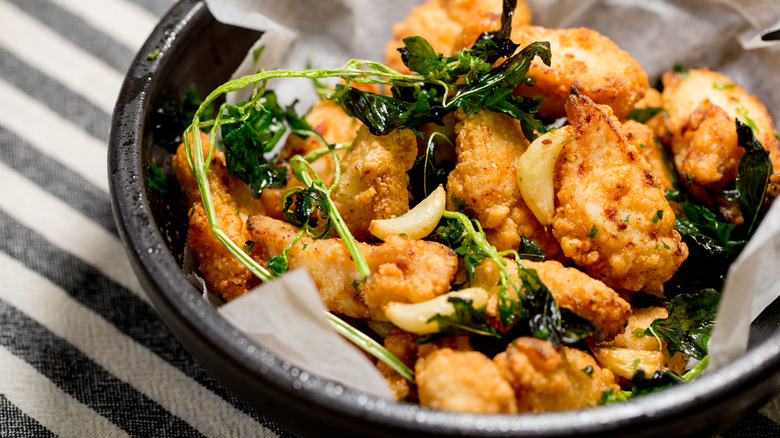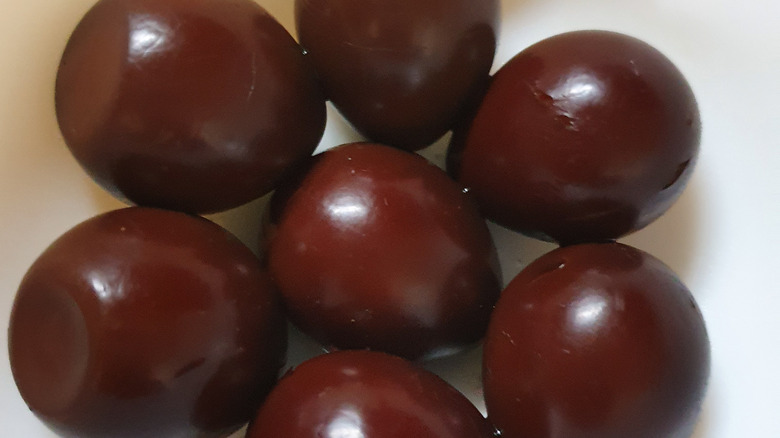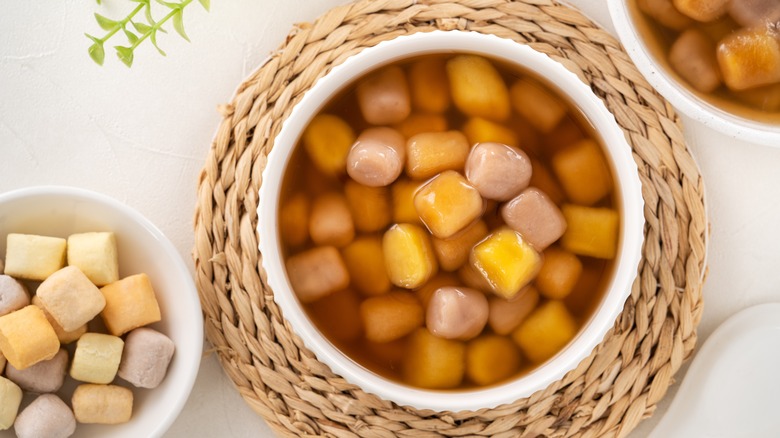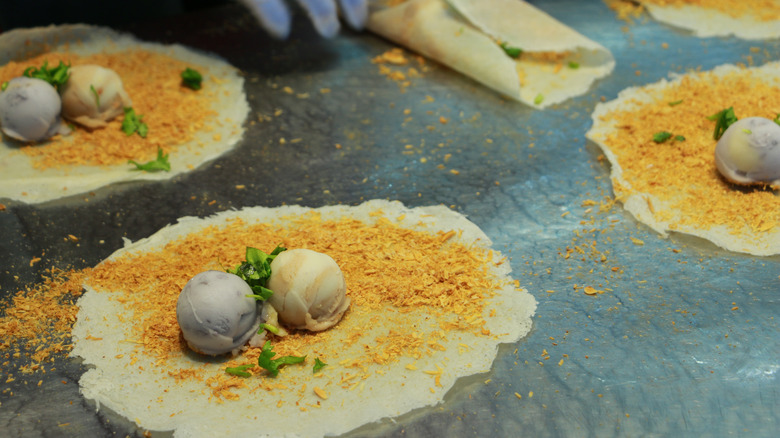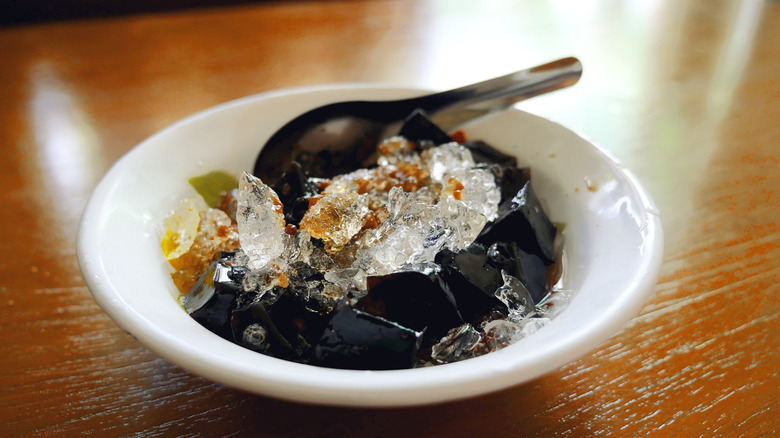Everything You Need To Know About Taiwan's Most Popular Street Foods
When chef and restaurateur Jennifer Hwa Dobbertin was a kid, she spent her summers in Taipei at her uncle's hawker stall, rolling dumplings with her mother and chasing down the stinky tofu cart with her cousins. Today, she's the owner of Best Quality Daughter in San Antonio, named by USA TODAY as one of the best new restaurants in the country. Her food is a blend of her Taiwanese heritage and her Texas upbringing, creating cuisine that challenges strict classifications of "culturally authentic" in favor of dishes that are authentic to her.
"My family has been selling street food for generations," she says, tracing a line back to her grandfather. He fled to Taiwan in 1949 after the Chinese Civil War, where he was a cook for an officer in Chiang Kai Shek's army. "When they got to Taiwan, my grandfather set up a stall with a barrel oven outside a mosque and sold baked bread to people going to worship."
For Jenn's family, owning a restaurant was not how they envisioned her life. "It was back-breaking for them," she said. "My uncle ran his shop his whole life, with no employees, working like 16 hours a day. Selling food was a means to an end."
"Now," she goes on, "selling food for me is this creative outlet that's elevated my life in so many ways."
Below, we look at the Taiwanese street food Jennifer grew up eating, which has influenced the cuisine that's brought her so much success.
Salty Soy Milk (Xian Dou Jiang)
Salty soy milk is a breakfast staple around Taiwan, where morning waits at the most popular purveyors can stretch for up to an hour. Like most breakfast foods, it's a simple, nutritious dish meant to fill you up for your day.
"It's not soy milk like a vegan would put in their coffee," says Jenn, whose mother's family was known for this dish at their restaurant. "It's more textural, like soft tofu. It's very silky."
According to The Woks of Life, that texture is achieved by slightly curdling soy milk with vinegar before incorporating an array of savory and pickled components.
"You add sesame oil, soy sauce, usually pickled mustard greens, and vinegar. And you get those Chinese churros, and you dip them in there and they soak up everything. You eat it with a soup spoon. It's definitely slurpable," Jenn notes.
Typical additions also include pickled radishes, mustard root, and flavored scallions, but the crispy crullers known as youtiao are what give the dish some textural contrast and help fill your belly.
"It's a very good hangover food," Jenn adds, which may account for the long weekend lines outside popular Taipei restaurants like Fu Hang Dou Jiang.
Oyster Vermicelli (O Ah Mee Sua)
This popular breakfast dish is uniquely Taiwanese, featuring wheat flour vermicelli noodles that have been steamed at a high temperature to caramelize them. They're served along with springy cured pig intestines and fresh oysters in a thick broth made with smoky bonito flakes. Diners can garnish their noodles with vinegar, pureed garlic, chili sauce, and cilantro, among other toppings (via Migrationology).
"There's a shop in the Ximending Night Market that's been there since the 70s," says Jenn, "And it's the first place we eat when we get to Taiwan. My mom and I just beeline there and we get two servings."
There's no seating at the always-busy Ay-Chung Flour-Rice Noodle, so patrons take their bowls to go, or more often, just stand outside the building and slurp on the street.
Beef Noodle Soup (Niu Rou Mian)
Also known as "braised beef noodles," beef noodle soup shares a similar history to Jennifer's family, having been brought over by soldiers fleeing China after the Civil War. This is the dish Jenn's uncle spent more than 30 years serving from his hawker stall in Taipei, providing (delicious) nourishment for his patrons and a living for his family.
"It's what most people say is the national dish of Taiwan," Jenn says. During her summers with her family as a kid, Jenn would spend mornings rolling dumplings with her mom for her uncle's businesses — as her uncle put dumplings in his version of beef noodle soup — while they watched Taiwanese soap operas.
Typically made with beef shank and tendon, and a rich, five-spiced broth with ginger, this popular noodle soup is found all over Taiwan. Yong-Kang Beef Noodle is a particularly popular spot for this dish, though the best version of braised beef noodles is a highly contested subject among locals, and everyone has their favorite spot.
Scallion Pancakes (Cong Zhua Bing)
The popular Taiwanese scallion pancake is commonly served with an egg and fried basil and accompanied by a wide selection of condiments like spicy sauce, sweet soy, kimchi, and cheese. "Scallion pancake is something my family has been making for generations," says Jenn.
"They're made from a laminated dough," Jenn explains. "You layer sesame oil, scallion, and a little salt and you roll it out. Then you do it again and you roll it and you do it again, and that's what makes them super flaky, like croissants."
It's a laborious process, she says, which is why you won't see them on the menu at her restaurant. "I like to make them at home, but it's very hard to do for 400 covers."
You will find them at food stalls all over Taipei, however. One, in particular, Hsiung Chi Scallion Pancake, situated at the end of an alley in Gongguan Night Market, is rated by the Michelin Guide.
Stinky Tofu (Chou Doufu)
"One of my favorite memories in Taiwan is the divisive stinky tofu," says Jenn. "I think it's delicious, and I'm not just saying that for credibility."
"They have a stinky tofu man, kind of like an ice cream cart, but his cart smells like sewage," she jokes. "He has this megaphone that plays this recording over and over. When we were kids and we could hear that from the apartment, we would run outside just like we heard an ice cream truck and catch the stinky tofu man out in the alleyway."
Like many great culinary delicacies, stinky tofu was the result of an accident. According to legend, a cook during the Chinese Qing Dynasty (1636-1911) discovered the dish after their stock of tofu went bad (via Taiwan Data Stories).
"It's like really funky blue cheese," Jenn says, "but it's got a little more of a rot profile to it. What really makes it are the sauces. It usually comes with a spicy chili bean sauce and pickled cabbage. So you have acid, spice, and salt, and then, like, a sewage-esque smell."
If you can get past the odor, the acid, spice, and salt of the accompaniments complement the rich flavor and creamy texture of the deep-fried tofu.
Oyster Omelet (O Ah Jian)
Perhaps the most ubiquitous street food in Taiwan, the oyster omelet is about as traditionally Taiwanese as it gets. The dish traces its origins back to the ancestral home of many Taiwanese people, China's Minnan region of the Fujian province (via Chef Denise).
The dish comes together quickly on a screaming hot flattop. Fresh oysters and greens are cooked in an egg batter that's thickened with sweet potato starch. It's then finished with a sweet red sauce and maybe some chili sauce for a kick.
You can find oyster omelets at any night market across Taiwan, but the underground section of the Shilin Night Market is particularly well-known for this national delicacy, as is the Ningxia Road Night Market, both in Taipei.
Taiwanese Meatballs (Ba Wan)
According to Justaiwantour, the Taiwanese meatballs, known as ba wan, originated more than a hundred years ago in Changhua county. Legend has it that, after a devastating flood in the region, a resident chef was given the recipe in a dream to keep the townspeople from starving. The divinely inspired dish has spread all over the country, with regional differences separating northern and southern styles of preparation.
To make Ba-wan, ground pork is mixed together with shiitake mushrooms, shallots, and bamboo shoots then stuffed inside a translucent, glutinous dough made of sweet potato starch. The steamed meatball is served in a starchy, savory broth with some sweet chili sauce.
"They're springy and chewy," says Jenn. "My mom would give them to me skewered on a chopstick when I was little and that was my kid snack."
Fried Chicken Cutlet (Zha Ji Pai)
The history of these plate-sized cutlets dates back to Japan's occupation of Taiwan during the first half of the 20th century, which may account for its similarity to Japanese katsu. The Taiwanese rendition has evolved away from its origins as bento box fare and into the oversized hand-held you find in the markets today.
"They're these large format chicken patties that they fry using sweet potato starch which gives them this signature light, airy crunch," says Jennifer.
According to Denise Macuk at Chef Denise, before being dusted in sweet potato starch and deep fried, a butterflied chicken breast is pounded flat and marinated in soy sauce, sesame oil, and spices.
"They've gotten really wild with them where they're like stuffed with cheese now, and all these different flavors and spices and stuff," says Jenn, who notes the dish's ubiquity on foodie Instagram feeds. "You can pull them apart and get that grammable cheesy pull."
Pork Belly Buns (Gua Bao)
Gua bao is probably the most familiar Taiwan street food to Western diners. Entire restaurant concepts around the U.S. are devoted to the fluffy steamed buns which are traditionally filled with braised and seared pork belly, pickled mustard greens, ground peanuts, and cilantro.
The "Taiwanese hamburger" (as it's sometimes called) is another dish transplanted from the old country of Fujian province in China. For many, it symbolizes wealth and prosperity, and is therefore often eaten during New Year's Eve celebrations in Taiwan.
Steamed buns in various forms are available at every market in Taiwan, with the traditional pork belly version described above served alongside variations made with roast duck, fried turkey, tofu, and infinite condiments (via Lacademie).
The Michelin Guide recognizes Lan Chia Guabao in the Gongguan Night Market as among the very best in a very crowded and competitive field.
Taro Balls with Pork Floss & Salted Egg Yolk
There's only one thing for sale at Liu Yu Zai, one of Taiwan's most famous food stalls: deep-fried taro balls filled with pork floss and stuffed with salted, cured egg yolk. According to DanielFoodDiary, the line for these Michelin-rated delicacies is always long, but the hawkers work quickly and expertly, and they're fun to watch while you wait.
To make the stuffed taro balls, mashed taro is formed into balls and filled with rousong — dried shredded pork with the consistency of cotton candy and known in the West as "pork floss." Optionally, customers can also choose to include a delicately salted egg yolk which has been cured for several days in salt and sugar. The whole thing is then deep fried and served hot, something like a Taiwanese croquette.
Sticky Rice Dumplings (Zongzi)
Traditionally associated with the early summer Dragon Boat Festival, zongzi are spiced, aromatic, sticky rice balls steamed in tetrahedrally-folded bamboo or lotus leaves. According to China Highlights, the festival commemorates the classical poet Qu Yuan where families give the dumplings as gifts. Seasonings, fillings, and flavors vary from region to region.
"They're my go-to starch at dim sum," says Jenn. "You season the rice when it's raw with oyster sauce and soy sauce and aromatics and peanuts, shiitake mushroom and Chinese sausage, then you mix it all together and then you steam it."
She adds, "They're really hard to fold!"
You can find them in shops and stalls all over Taiwan throughout the year, but they become especially prevalent in May and June -– the fifth month of the lunar year. Their centrality to the Dragon Boat celebrations has garnered it the nickname "Bak Chang," or "Dumpling Festival."
Small Sausage Wrapped in Large Sausage (Da Chang Bao Xiao Chang)
At first glance, you might mistake this playful street food dish for a traditional ballpark frank. The night market rendition of a hot dog, however, puts a decidedly Taiwanese spin on the Western classic.
The "large sausage" in question is glutinous sticky rice, lightly grilled and split longways. A grilled pork sausage is laid inside and dressed in a bevy of condiments that can include garlic cloves, ginger, chili sauce, pickled veggies, and sweet soy sauce (via Nick Kembel).
"I've had this before in New York at a restaurant called 886," Jenn says, "and that was the first time I'd ever seen it, so I guess they have their finger on the pulse of what's cool in Taiwan."
If you're in Taichung, you can find the Taiwanese take on a hot dog at Feng Chia Night Market.
Popcorn Chicken (Yansu Ji)
In contrast to the century-old history behind the fried chicken cutlet, Taiwanese popcorn chicken can trace its lineage to a brilliant woman called Mrs. Yeh who, in 1979, reimagined the popular fried chicken found on fast food menus across the West. Her version uses bite-sized chicken thigh pieces marinated in soy sauce, rice wine, garlic, and ginger. It's then dredged in sweet potato starch and deep-fried.
"We have them on our menu at Best Quality Daughter," says Jennifer. "We marinate it overnight, fry them to order, and toss them in what we call Taiwanese pepper salt which is just Szechuan pepper, sugar, a little MSG, white pepper, and five spice and salt."
"Traditionally, when you get it at the night market," she goes on, "it doesn't usually come with a dipping sauce. It just comes with pieces of whole fried Thai basil. Trying to keep it Texas, we wanted it to be reminiscent of a fried chicken tender plate, so we serve it with a Thai basil ranch dip."
Iron Eggs (Tiedan)
Like a few dishes on this list, so-called iron eggs might be an acquired taste for Western palates. Often mistaken for century eggs, which are buried and fermented for weeks, iron eggs are stewed and air-dried 11 times to achieve the trademark black color and chewy texture.
Originating as snacks made for dockhands in a district of Taipei called Tamsui or Danshui, iron eggs are a popular grab-and-go snack for busy Taiwanese people. To make them, cooks will hard boil chicken, pigeon, or quail eggs in soy sauce or strong tea, peel them, and take them through a week-long process that can involve slow cooking the eggs over and over in a variety of spices and herbs (via Flavor & Fortune). The result is a strongly flavored version of the soy egg with a springy, chewy texture known as "QQ."
Unaccustomed newcomers may find them challenging at first, but they're a favorite among locals. They can be found in most grocery and convenience stores vacuum-sealed under plastic, but for a more handmade version, go to Granny's Iron Eggs in New Taipei City's Tamusi district.
Jiufen Sweet Potato & Taro Balls
These syrupy-sweet confections are a famous delicacy in the former gold mining town on the northeast coast of Taiwan called Jiufen. They're found all over Taiwan, served either warm or over shaved ice as an accompaniment with other flavors like mango.
To make them, fresh taro or sweet potatoes are peeled, boiled, then steamed until well done, then mashed and mixed with sweet potato starch. They're rolled out, cut into bite-sized pieces, and cooked a final time to achieve their signature chewy, elastic "QQ" texture. Other flavors include Chinese yam, green tea, and sesame.
Grandma Lai's Sweet Taro Balls in Jiufen is known as one of the best scratch-made purveyors of these springy treats. The store in the middle of the scenic Jiufen Old Street has been making taro and sweet potato balls by hand for three generations.
Peanut Ice Cream Wraps
Just down from Grandma Lai's in Jiufen is A-Zhu's Peanut Ice Cream Roll, a stall that specializes in a frozen dessert that sounds a little strange but is totally delicious.
A rice paper skin is filled with Taiwanese coconut ice cream — usually, pineapple or taro flavored. Hawkers will chip bits of peanut brittle candy off an enormous block and garnish the ice cream along with a few sprigs of fresh cilantro before wrapping it up like a spring roll (via Lacademie). While the flavor combinations might not make intellectual sense, the experience is incredibly satisfying as an after-dinner treat.
Jiufen certainly isn't the only place to find these unique confections. Night markets all over the country have their own versions you can try.
Shaved Ice (Chua Bing)
"Every Asian country has their shaved ice dessert," says Jenn. In Taiwan, you'll usually find a buffet of toppings like fruits, red bean paste, chewy tapioca balls, and brown sugar syrup. Particularly popular is mango shaved ice, a fruity sweet treat supposedly invented on Yong Kang Street in Taipei (via Chef Denise).
While it might get the most press, mango shaved ice is only one of the seemingly infinite flavor combinations you can choose to top your shaved ice with.
"The only one I ever pick is black grass jelly," Jenn says. "It's not overly sweet and has an herbal and floral mild taste to it. It's chunks of black jelly and you smash it up in shaved ice. I want it with brown sugar and simple syrup and that's it. Lychee is very popular. So are taro and sweet potato balls, but I don't like it that way. I'm a purist."
